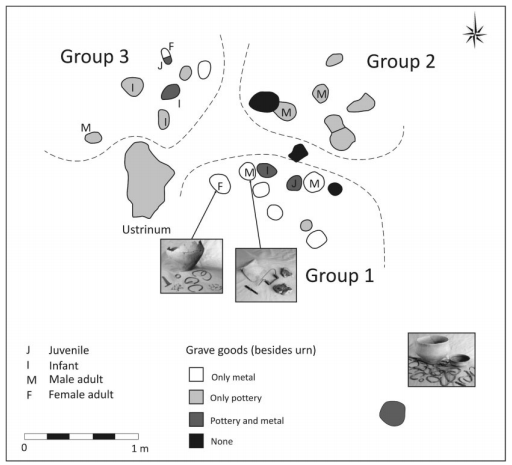Arroyo Culebro D
- Period: Bronze Age to Iron Age
- Location: Spain
- Burials: 30 individuals
- Archaeologists:J. de Torres Rodrigues
- Related Keyword/Categories: Cremation, Inhumation, Funerary Practice

The site under analysis is Arroyo Culebro D, which is found 6 km from Madrid, and was excavated in 2000. The cemetery has only 30 burial pits, but does have evidence of an ustrinum- the site where the bodies are burned upon a pyre. The majority of these remains were placed in urns and then buried at the site. One inhumation was found at the site, and a number of cremated remains were placed in the grave pit without an urn, but covered by a pot. The cemetery was only used for a short period of time during the 6th century BC. The urns were primarily undecorated, but some have flaring details. Grave goods include bronze bracelets, buckles, tweezers, quartz stones and bone pendants. Analysis of the cemetery discovered that there were three different groups divided by space and grave goods: 1) adult individuals with metallic grave goods (although one infant and one juvenile also fit this category) that were buried in organized rows, 2) adult individuals with only pottery and no clear spatial patterning, and 3) a mixed group on the west side of the cemetery that includes most juvenile and infant burials, as well as the only inhumation and double grave, and have a variety of grave goods. Based on this analysis, Rodríguez (2014) argues that there was a clear distinction between the prestigious group 1 and not so prestigious group 2. Groups were becoming spatially different, with different grave goods to show their varied status. The presence of subadults in group 1, supports the idea that the status of this group was not acquired, but was based on familial ties. The clear spatial divisions and grave good differences aid the interpretation that social inequality was beginning to appear in this community, and even in death groups were trying to show their prestige and status. Rodríguez (2014) concludes that this cemetery supports the assertion that agriculture and sedentism lead to social inequality.
References: J. de Torres Rodrigues (2014). A Place for Everyone. The Structure of Arroyo Culebro D Cemetery and the Social Organization in the Middle Targus Valley Iron Age. Oxford Journal of Archaeology, DOI: 10.1111/ojoa.12032


